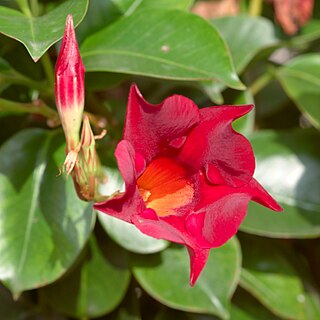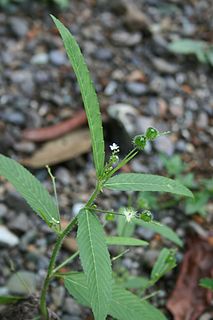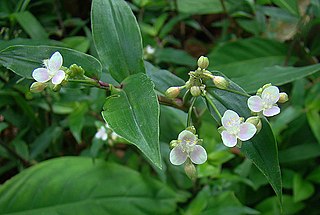
Psidium is a genus of trees and shrubs in the family Myrtaceae. It is native to warmer parts of the Western Hemisphere.

Mandevilla is a genus of tropical and subtropical flowering vines belonging to the family Apocynaceae. It was first described as a genus in 1840. A common name is rocktrumpet.

Cnidoscolus is a plant genus of the family Euphorbiaceae first described as a genus in 1827. The group is widespread across much of North and South America, including the West Indies.

Caperonia is a genus of plants of the family Euphorbiaceae first described as a genus in 1825. The genus is native to tropical and subtropical America and Africa.
Philyra is a plant genus of the family Euphorbiaceae first described as a genus in 1841. It contains only one known species, Philyra brasiliensis, native to Brazil, Paraguay, and northeastern Argentina.

Manihot is a genus in the diverse milkspurge family, Euphorbiaceae. It was described as a genus in 1754.

Stillingia is a plant genus of the family Euphorbiaceae, first described for modern science as a genus in 1767. The genus is native to Latin America, the southern United States, and various islands in the Pacific and Indian Oceans. Toothleaf is a common name for plants in this genus.
Actinostemon is a plant genus of the family Euphorbiaceae first described as a genus in 1841. It is native to South America, Central America, and the West Indies.

Microstachys is a genus of plants in the Euphorbiaceae first described as a genus in 1824. It is native to tropical Africa, southern Asia, Australia, Papuasia, Mesoamerica, the West Indies, and South America.
Gonatogyne is a genus of plants in the family Phyllanthaceae first described as a genus in 1873. It contains only one known species, Gonatogyne brasiliensis, endemic to southeastern Brazil.

Myrciaria is a genus of large shrubs and small trees described as a genus in 1856. It is native to Central and South America, Mexico, and the West Indies, with many of the species endemic to Brazil. Common names include hivapuru, sabará, and ybapuru.

Billbergia is a genus of flowering plants in the family Bromeliaceae, subfamily Bromelioideae. The genus, named for the Swedish botanist, zoologist, and anatomist Gustaf Johan Billberg, is divided into two subgenera: Billbergia and Helicodea. They are native to forest and scrub, up to an altitude of 1,700 m (5,577 ft), in southern Mexico, the West Indies, Central America and South America, with many species endemic to Brazil.

Dyckia is a genus of plants in the family Bromeliaceae, subfamily Pitcairnioideae.

Oxypetalum is a genus of flowering plants in the family Apocynaceae, first described with this name in 1810. The genus is native to South America.

Sarcoglottis is a genus of flowering plants from the orchid family, Orchidaceae. It is widespread across much of Latin America from Mexico to Argentina, with one species extending northward into Trinidad and the Windward Islands.

Skeptrostachys is a genus of flowering plants from the orchid family, Orchidaceae. It is native to eastern South America.

Herreria is a genus of flowering plants native to South America. In the APG III classification system, the genus is placed in the family Asparagaceae, subfamily Agavoideae.
- Herreria bonplandiiLecomte - Argentina, Paraguay, Uruguay
- Herreria cipoanaRavenna - Minas Gerais
- Herreria glazioviiLecomte - Bolivia, Brazil
- Herreria grandifloraGriseb. - Rio de Janeiro
- Herreria latifoliaWoodson - Minas Gerais, Bolivia
- Herreria montevidensisKlotzsch ex Griseb. in C.F.P.von Martius - Argentina, Paraguay, Uruguay, Bolivia
- Herreria salsaparilhaMart. - Brazil
- Herreria stellataRuiz & Pav. - Chile

Eriope is a genus of plants in the family Lamiaceae, first described in 1833. It is native to South America, many of the species endemic to Brazil.
- Eriope alpestrisMart. ex Benth. - Minas Gerais
- Eriope anamariaeHarley - Bahia
- Eriope angustifoliaEpling - Minas Gerais
- Eriope arenariaHarley - Minas Gerais
- Eriope blanchetii(Benth.) Harley - northeastern Brazil
- Eriope complicataMart. ex Benth. - Brazil
- Eriope confusaHarley - Bahia
- Eriope crassifoliaMart. ex Benth. - Bahia
- Eriope crassipesBenth. - Brazil, Paraguay, Venezuela, French Guiana, Bolivia, Colombia
- Eriope exaltataHarley - Bahia
- Eriope filifoliaBenth. - Minas Gerais
- Eriope foetidaA.St.-Hil. ex Benth. - Brazil
- Eriope glandulosa(Harley) Harley - Bahia, Minas Gerais
- Eriope hypenioidesMart. ex Benth. - Bahia
- Eriope hypoleuca(Benth.) Harley - Bahia, Minas Gerais
- Eriope latifolia(Mart. ex Benth.) Harley - eastern Brazil
- Eriope luetzelburgiiHarley - Bahia
- Eriope machrisae(Epling) Harley - Goiás
- Eriope macrostachyaMart. ex Benth. - Brazil, Paraguay, Venezuela
- Eriope montanaHarley - Bahia
- Eriope monticolaMart. ex Benth. - Bahia
- Eriope obovataEpling - northeastern Brazil
- Eriope parvifoliaMart. ex Benth. - Brazil
- Eriope polyphyllaMart. ex Benth. - Bahia
- Eriope salviifolia(Pohl ex Benth.) Harley - Bahia, Minas Gerais
- Eriope sincoranaHarley - Bahia
- Eriope tumidicaulisHarley - Bahia
- Eriope velutinaEpling - Brazil
- Eriope xavantiumHarley - Mato Grosso

Tripogandra is a genus of flowering plants in the spiderwort family, Commelinaceae. It is native to the Western Hemisphere from central Mexico and the West Indies south to Argentina.

Bia is a genus of plant of the family Euphorbiaceae first described as a genus in 1841. The entire genus is native to South America.
- Bia alienataDidr. - Brazil, Bolivia, Paraguay, N Argentina
- Bia capivarensisMedeiros & Alves - Serra da Capivara
- Bia fallax(Müll.Arg.) G.L.Webster - Peru, Rondônia
- Bia fendleri(Müll.Arg.) G.L.Webster - Guyana, Venezuela, Amazonas State of Brazil
- Bia lessertianaBaill. - Fr Guiana, Suriname, Guyana, N Brazil
- Bia manueliiV.W. Steinm. & Ram.-Amezcua, 2013, Sierra de Coalcomán, Michoacán, Mexico

















